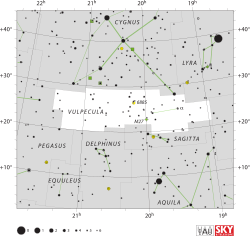| Observation data Epoch J2000 Equinox J2000 | |
|---|---|
| Constellation | Vulpecula |
| Right ascension | 19h 59m 10.5367s [1] |
| Declination | +23° 06′ 04.604″ [1] |
| Apparent magnitude (V) | 5.68 [2] |
| Characteristics | |
| Spectral type | F1 Vn [3] |
| B−V color index | 0.345±0.004 [2] |
| Astrometry | |
| Radial velocity (Rv) | −38.0±3.7 [4] km/s |
| Proper motion (μ) | RA: −68.157±0.100 [1] mas/yr Dec.: 6.926±0.125 [1] mas/yr |
| Parallax (π) | 18.7753±0.1714 mas [1] |
| Distance | 174 ± 2 ly (53.3 ± 0.5 pc) |
| Absolute magnitude (MV) | 2.23 [2] |
| Details | |
| Mass | 1.52 [5] M☉ |
| Luminosity | 11.09 [2] L☉ |
| Surface gravity (log g) | 3.81±0.14 [5] cgs |
| Temperature | 6,938±236 [5] K |
| Metallicity [Fe/H] | −0.36 [4] dex |
| Rotational velocity (v sin i) | 150 [6] km/s |
| Age | 1.743 [5] Gyr |
| Other designations | |
| 14 Vul, BD+22° 3872, HD 189410, HIP 98375, HR 7641, SAO 88016 [7] | |
| Database references | |
| SIMBAD | data |
14 Vulpeculae is a single, [8] yellow-white hued star in the northern constellation of Vulpecula and proximate to the Dumbbell Nebula (M 27) on the celestial sphere, although actually much closer to the Earth. [9] It is a dim star that is faintly visible to the naked eye with an apparent visual magnitude of 5.68. [2] The distance to 14 Vul, as determined from its annual parallax shift of 18.7753±0.1714, [1] is around 174 light years. It is moving nearer with a heliocentric radial velocity of about −38 km/s, [4] and will make its closest approach in a million years when comes to within about 62 ly (19.04 pc). [2]
This is an F-type main-sequence star with a stellar classification of F1 Vn, [3] where the 'n' notation indicates nebulous lines due to rapid rotation. At the estimated age of 1.7 [5] billion years old, it is spinning with a projected rotational velocity of 150 [6] km/s and has sub-solar metallicity. [4] The star has 1.5 [5] times the mass of the Sun and is radiating 11 [2] times the Sun's luminosity from its photosphere at an effective temperature of about 6,938 K. [5]
